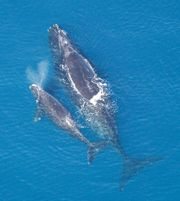 The leading cause of death among North Atlantic right whales, which migrate through some of the world’s busiest shipping lanes whilst journeying off the east coast of the United States and Canada, is injury sustained from being struck by ships. But there is some good news. Here’s a recent article from the Savannah Morning News about a new federal recommendation.
The leading cause of death among North Atlantic right whales, which migrate through some of the world’s busiest shipping lanes whilst journeying off the east coast of the United States and Canada, is injury sustained from being struck by ships. But there is some good news. Here’s a recent article from the Savannah Morning News about a new federal recommendation.
A new federal report recommends that ships entering and exiting the port of Savannah and other ports along the East Coast slow to 10 knots (about 12 mph) to protect highly endangered right whales.
“Our scientific analysis shows that a 10-knot speed limit in critical areas will significantly reduce the threat to these endangered marine mammals,” said retired Navy Vice Admiral Conrad C. Lautenbacher Jr., undersecretary of commerce for oceans and atmosphere and NOAA administrator.
If adopted, the measure is expected to have an impact of $3.6 million a year on commercial shipping in Savannah.
Savannah is just one of 17 East Coast ports from Boston to Port Canaveral, Fla., affected by the suggested restrictions on ship speed. Right whales feed off the coast of New England and give birth off the coasts of north Florida and south Georgia.
In the environmental impact statement issued Monday by the National Oceanic and Atmospheric Administration, Savannah is assigned to the mid-Atlantic region. NOAA suggests the best protection for whales in this area would come from ships 65 feet long or larger slowing to 10 knots within 20 nautical miles of shore for the six months of the year – from Nov. 1 to April 30 – when whales transit the region.
Similar protections would extend along the coast at various times of the year. If implemented, they’re expected to save one or two whales a year from a population of only 300-400.
“If we can save even one or two whales, we can tip the survivability curve to where we can see an increase in the population rather than a decrease,” Lautenbacher said.
Often called urban whales because they live in close proximity to cities along the coast, right whales are mainly threatened by ship strikes and entanglement in fishing gear. They were hunted to near extinction because their slow swimming speed and tendency to float when dead made them the “right” whale to catch.
Ships typically travel at about 15-22 knots in the affected regions, Lautenbacher said. At the reduced speed, whales will be better able to get out of their way and won’t be as likely to be mortally wounded if they are hit.
“It’s a very positive step for the conservation of right whales,” said Reed Bohne, NOAA’s regional director for sanctuary program for the Northeast and Great Lakes Region and former sanctuary manager of Gray’s Reef National Marine Sanctuary.
Monday’s report was more than five years in the making but includes a sunset provision that allows for adjustment in the rule based on new research.
Georgia Ports Authority spokesman Robert Morris said Monday that GPA had not finished reviewing the document, but would likely welcome the sunset clause in part because of technology it’s working on to track whales and warn ships of their presence.
The monitor seeks to record whales as they communicate with each other. The current warning system is based on costly and spotty visual sightings.
“When whales are communicating, the buoy sound systems would pick it up and communicate it to the Coast Guard and ships that whales are in the vicinity,” Morris said. “This is the kind of technology that could change the whole nature of the discussion.”
Tom Wright, a member of the Savannah Maritime Association, has followed the right whale situation closely. He, too, was cheered by the sunset clause. The U.S. is already developing a plan to enhance port and coastline security, he said.
“The same systems that will provide the underwater view will be able to detect right whales and slow down vessels when necessary, rather than arbitrarily during a calendar period,” Wright said.
Such a system could be used to warn all vessels.
“The last right whale ship strike in Georgia waters involved a vessel less than 65 feet in length,” Wright said. “NOAA needs to consider these vessels also. If the sensors were in place, the federal and state governments together could restrict all traffic that threatens the whales when they are detected.”
What’s next?
The final environmental impact statement issued Monday to reduce ship strikes to North Atlantic right whales is one of the last steps in the process to implement a ship strike rule. The public has until Sept. 29 to comment on the statement. The National Oceanic and Atmospheric Administration expects its final rule to be issued by December.
On the Web
The impact statement is available at nmfs.noaa.gov/pr/shipstrike/eis.htm.









